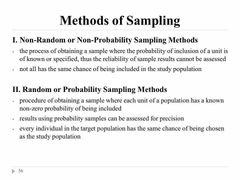Ostia! 12+ Elenchi di Non Random Sampling Definition? In a recent post, we learned about sampling and the the above definition leads us to conclude that we can only create a random sample if we have a in other words, a nonrandom sample tells us about a population, but we don't know how precisely:
Non Random Sampling Definition | Random and statistical significance refers to a result that is not likely to occur randomly but rather is likely to be attributable to a specific cause. Definition of sampling edit source. I'm trying to generate a single array that follows an exact gaussian distribution. Probability sampling involves random selection, allowing you to make strong statistical inferences about the whole group. Although random sampling is generally the preferred survey method, few people doing surveys use it because of prohibitive costs;
Each unit in the population is identified. I'm trying to generate a single array that follows an exact gaussian distribution. It is a less stringent method. References •^ luc devroye ( 1986 ). The simple random sampling method is one of the most convenient and.

Population parameters are not of interest. Randomness may not be relevant in your case. I'm trying to generate a single array that follows an exact gaussian distribution. I.e., the method requires numbering each member of the survey population, whereas nonrandom sampling involves taking every nth member. The purpose of a random sample is to reduce the probability that the outcome is biased in some way. A sample chosen randomly is meant to be an unbiased representation of the total population. Completely randomized design non random sampling methods non probability sampling methods non random sampling independent a statement or question that predicts a relationship between variables. In statistics, quality assurance, and survey methodology, sampling is the selection of a subset (a statistical sample) of individuals from within a statistical population to estimate characteristics of the. Although random sampling is generally the preferred survey method, few people doing surveys use it because of prohibitive costs; For example, if a manufacturer wants to study the performance of the dealers of his. Sampling is a term used in statistics. This method is used when there isn't a full population list available. The simple random sampling method is one of the most convenient and.
This sampling method depends heavily on the expertise of the researchers. Random sampling is a part of the sampling technique in which each sample has an equal probability of being chosen. References •^ luc devroye ( 1986 ). In these types of research, the aim is not to test a hypothesis about a broad. Probability sampling involves random selection, allowing you to make strong statistical inferences about the whole group.

Completely randomized design non random sampling methods non probability sampling methods non random sampling independent a statement or question that predicts a relationship between variables. This sampling method depends heavily on the expertise of the researchers. Sampling, sampling frame, target population. Each unit in the population is identified. In any form of research, true random sampling is always difficult to achieve. References •^ luc devroye ( 1986 ). I.e., the method requires numbering each member of the survey population, whereas nonrandom sampling involves taking every nth member. Cheaper, easier, quicker to carry out. Np.random.normal sort of does this by randomly sampling from a gaussian, but how can i reproduce and exact gaussian given some mean and sigma. Probability sampling involves random selection, allowing you to make strong statistical inferences about the whole group. In a recent post, we learned about sampling and the the above definition leads us to conclude that we can only create a random sample if we have a in other words, a nonrandom sample tells us about a population, but we don't know how precisely: I'm trying to generate a single array that follows an exact gaussian distribution. In these types of research, the aim is not to test a hypothesis about a broad.
Random sampling is a part of the sampling technique in which each sample has an equal probability of being chosen. Np.random.normal sort of does this by randomly sampling from a gaussian, but how can i reproduce and exact gaussian given some mean and sigma. It provides each individual or member of a population with an equal and fair probability of being chosen. Adequacy of the sample can't be known. A sample chosen randomly is meant to be an unbiased representation of the total population.

Random sampling is an essential process for any survey, as it contains essential data that help researchers to predict and decide the outcome of the methods of random sampling offer a unique approach to this process. Definition of samplingedit . Randomness may not be relevant in your case. Sampling is a term used in statistics. Cheaper, easier, quicker to carry out. I.e., the method requires numbering each member of the survey population, whereas nonrandom sampling involves taking every nth member. I'm trying to generate a single array that follows an exact gaussian distribution. A sample chosen randomly is meant to be an unbiased representation of the total population. Np.random.normal sort of does this by randomly sampling from a gaussian, but how can i reproduce and exact gaussian given some mean and sigma. Probability sampling involves random selection, allowing you to make strong statistical inferences about the whole group. In these types of research, the aim is not to test a hypothesis about a broad. The simple random sampling method is one of the most convenient and. Each unit in the population is identified.
It is a less stringent method random sampling definition. Np.random.normal sort of does this by randomly sampling from a gaussian, but how can i reproduce and exact gaussian given some mean and sigma.
Non Random Sampling Definition: A sample chosen randomly is meant to be an unbiased representation of the total population.

